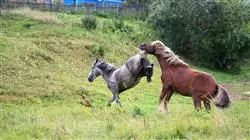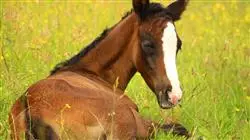University certificate
The world's largest faculty of veterinary medicine”
Introduction to the Program
You will learn to recognize medical and surgical genital pathologies of the stallion and the mare dam, assess their extent and provide appropriate treatments for recovery and restoration of proper reproductive function"

First, the medical pathologies of the male and female will be presented, followed by the surgical pathologies. All these issues will be presented in the necessary breadth, increasing the student's skills in traditional practices as well as in novel procedures and the latest researched techniques. This program will also address the main alterations that can affect the urinary system; these can compromise the physical condition of the animal to the point of reducing its performance or even limiting the patient's life. Possible diagnostic tests will be reviewed and treatment alternatives will be extensively established.
This Postgraduate diploma, especially dedicated to foals, will present the possible medical and surgical pathologies likely to appear during the neonatal and pediatric period of the equine, always presenting updated exploration and diagnostic techniques and modernized treatment protocols representative of the latest advances in this field of veterinary medicine.
In addition, students in this program will have the opportunity to participate in a series of exclusive Masterclasses given by a leading international expert in the equine field. These masterclasses will focus on the approach to various pathologies related to Reproduction and Neonatology, offering a complete and up-to-date vision of the most advanced therapeutic techniques and strategies.
Students will thereby be able to broaden their knowledge and competencies according to the highest veterinary level, and apply them in their professional practice.
Finally, the student will receive specialized education on euthanasia procedures, essential in daily practice since this is a delicate assistance that must always be practiced with advanced knowledge to ensure the minimum suffering for patients. In this way, professionals will update their knowledge not only in reproduction but also in topics related to neonatology.
The Masterclasses included in the educational program will allow you to gain an in-depth understanding of the latest equine diagnostic and approach techniques"
This Postgraduate diploma in Equine Reproduction and Neonatology contains the most complete and up-to-date scientific program on the market. The most important features include:
- The latest technology in online teaching software
- A highly visual teaching system, supported by graphic and schematic contents that are easy to assimilate and understand
- Practical cases presented by practicing experts
- State-of-the-art interactive video systems
- Teaching supported by telepractice
- Continuous updating and recycling systems
- Autonomous learning: full compatibility with other occupations
- Practical exercises for self-assessment and learning verification
- Support groups and educational synergies: questions to the expert, debate and knowledge forums
- Communication with the teacher and individual reflection work
- Content that is accessible from any fixed or portable device with an Internet connection
- Supplementary documentation databases are permanently available, even after finishing the course
Our innovative telepractice concept will give you the opportunity to learn through an immersive experience, which will provide you with a faster integration and a much more realistic view of the contents: “learning from an expert”
The program’s teaching staff includes professionals from the field who contribute their work experience to this educational program, as well as renowned specialists from leading societies and prestigious universities.
The multimedia content, developed with the latest educational technology, will provide the professional with situated and contextual learning, i.e., a simulated environment that will provide immersive education programmed to prepare for real situations.
This program is designed around Problem-Based Learning, whereby the professional must try to solve the different professional practice situations that arise during the course. For this purpose, the students will be assisted by an innovative interactive video system created by renowned and experienced experts.
With the experience of working professionals and the analysis of real success stories, in a high-impact educational approach"

This program will enable the clinician to correctly assess the systemic status of the animal and the consequent severity of the pathology and its treatment"
Why study at TECH?
TECH is the world’s largest online university. With an impressive catalog of more than 14,000 university programs available in 11 languages, it is positioned as a leader in employability, with a 99% job placement rate. In addition, it relies on an enormous faculty of more than 6,000 professors of the highest international renown.

Study at the world's largest online university and guarantee your professional success. The future starts at TECH”
The world’s best online university according to FORBES
The prestigious Forbes magazine, specialized in business and finance, has highlighted TECH as “the world's best online university” This is what they have recently stated in an article in their digital edition in which they echo the success story of this institution, “thanks to the academic offer it provides, the selection of its teaching staff, and an innovative learning method aimed at educating the professionals of the future”
A revolutionary study method, a cutting-edge faculty and a practical focus: the key to TECH's success.
The most complete study plans on the university scene
TECH offers the most complete study plans on the university scene, with syllabuses that cover fundamental concepts and, at the same time, the main scientific advances in their specific scientific areas. In addition, these programs are continuously being updated to guarantee students the academic vanguard and the most in-demand professional skills. In this way, the university's qualifications provide its graduates with a significant advantage to propel their careers to success.
TECH offers the most comprehensive and intensive study plans on the current university scene.
A world-class teaching staff
TECH's teaching staff is made up of more than 6,000 professors with the highest international recognition. Professors, researchers and top executives of multinational companies, including Isaiah Covington, performance coach of the Boston Celtics; Magda Romanska, principal investigator at Harvard MetaLAB; Ignacio Wistumba, chairman of the department of translational molecular pathology at MD Anderson Cancer Center; and D.W. Pine, creative director of TIME magazine, among others.
Internationally renowned experts, specialized in different branches of Health, Technology, Communication and Business, form part of the TECH faculty.
A unique learning method
TECH is the first university to use Relearning in all its programs. It is the best online learning methodology, accredited with international teaching quality certifications, provided by prestigious educational agencies. In addition, this disruptive educational model is complemented with the “Case Method”, thereby setting up a unique online teaching strategy. Innovative teaching resources are also implemented, including detailed videos, infographics and interactive summaries.
TECH combines Relearning and the Case Method in all its university programs to guarantee excellent theoretical and practical learning, studying whenever and wherever you want.
The world's largest online university
TECH is the world’s largest online university. We are the largest educational institution, with the best and widest online educational catalog, one hundred percent online and covering the vast majority of areas of knowledge. We offer a large selection of our own degrees and accredited online undergraduate and postgraduate degrees. In total, more than 14,000 university degrees, in eleven different languages, make us the largest educational largest in the world.
TECH has the world's most extensive catalog of academic and official programs, available in more than 11 languages.
Google Premier Partner
The American technology giant has awarded TECH the Google Google Premier Partner badge. This award, which is only available to 3% of the world's companies, highlights the efficient, flexible and tailored experience that this university provides to students. The recognition as a Google Premier Partner not only accredits the maximum rigor, performance and investment in TECH's digital infrastructures, but also places this university as one of the world's leading technology companies.
Google has positioned TECH in the top 3% of the world's most important technology companies by awarding it its Google Premier Partner badge.
The official online university of the NBA
TECH is the official online university of the NBA. Thanks to our agreement with the biggest league in basketball, we offer our students exclusive university programs, as well as a wide variety of educational resources focused on the business of the league and other areas of the sports industry. Each program is made up of a uniquely designed syllabus and features exceptional guest hosts: professionals with a distinguished sports background who will offer their expertise on the most relevant topics.
TECH has been selected by the NBA, the world's top basketball league, as its official online university.
The top-rated university by its students
Students have positioned TECH as the world's top-rated university on the main review websites, with a highest rating of 4.9 out of 5, obtained from more than 1,000 reviews. These results consolidate TECH as the benchmark university institution at an international level, reflecting the excellence and positive impact of its educational model.” reflecting the excellence and positive impact of its educational model.”
TECH is the world’s top-rated university by its students.
Leaders in employability
TECH has managed to become the leading university in employability. 99% of its students obtain jobs in the academic field they have studied, within one year of completing any of the university's programs. A similar number achieve immediate career enhancement. All this thanks to a study methodology that bases its effectiveness on the acquisition of practical skills, which are absolutely necessary for professional development.
99% of TECH graduates find a job within a year of completing their studies.
Postgraduate Diploma in Equine Reproduction and Neonatology
TECH Global University invites you to participate in our Postgraduate Diploma in Equine Reproduction and Neonatology, a unique opportunity to acquire specialized knowledge in the field of equine reproduction. Equine reproduction and care requires highly qualified professionals, and our Postgraduate Diploma is designed to provide you with the necessary skills to excel in this area. At TECH Global University, we understand that your time is valuable. That's why we have developed an online Postgraduate Diploma, which allows you to study from the comfort of your home or anywhere with an Internet connection. Online classes offer unparalleled flexibility, allowing you to organize your studies according to your schedule and personal commitments. In addition to convenience, online classes also offer a number of benefits. You'll be able to access quality teaching materials, participate in online discussions with experts in the field and collaborate with peers from around the world. You'll also have the support of our highly qualified faculty, who will provide you with personalized guidance and feedback throughout your learning.
Your path to excellence in equine reproduction
In our Postgraduate Diploma in Equine Reproduction and Neonatology, you'll immerse yourself in the key aspects of equine reproduction, including the reproductive cycle, artificial insemination, embryo transfer and neonatal management. You will learn the most advanced techniques and best practices in the care and management of equines at these critical stages. In addition, you will have the opportunity to perform field practices and apply your knowledge in real situations. Our Postgraduate Diploma will provide you with the theoretical and practical tools necessary to become an expert in equine reproduction and neonatology. Don't miss this opportunity to boost your career in the field of equine reproduction. Enroll now in our Postgraduate Diploma in Equine Reproduction and Neonatology and acquire the knowledge and skills you need to become a leader in this exciting field. Your success in equine reproduction is just a click away!







